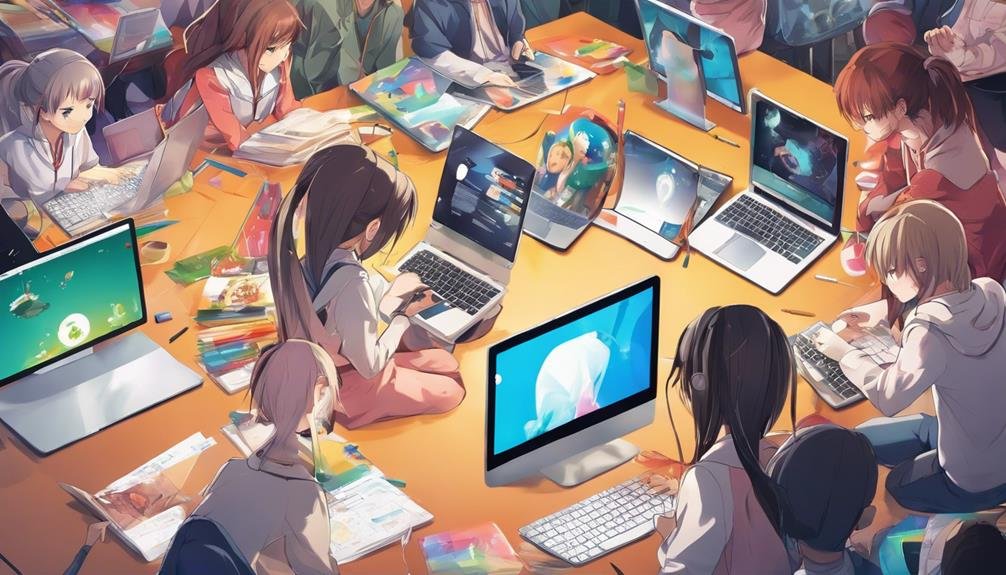What Are the Best Strategies for Creating Interactive E-Learning Experiences?
Enhance your e-learning with multimedia like videos and simulations for simplicity and engagement. Gamification with rewards and challenges boosts motivation and immersion. Interactive quizzes and varied assessments encourage active learning and immediate feedback. Collaborative projects deepen understanding through peer interactions. Personalize learning paths and offer adaptive content for individual progress. Set goals, provide feedback, and use storytelling to engage learners. Explore virtual reality for immersive experiences. For a detailed guide on creating interactive e-learning, uncover the secrets beyond these strategies.
Key Takeaways
- Incorporate multimedia elements like videos and animations for visual understanding.
- Utilize gamification techniques to enhance engagement and motivation.
- Design interactive assessments with immediate feedback for active learning.
- Encourage collaborative learning through group projects and peer interactions.
- Personalize learning paths to cater to individual learning styles and pace.
Incorporating Multimedia Elements
To guarantee engagement and interactivity in e-learning, consider incorporating a variety of multimedia elements such as videos, interactive simulations, and animations. Interactive animations can make complex concepts easier to understand by visually demonstrating processes or systems. By integrating multimedia elements like engaging video content, learners can stay more focused and retain information better.
Videos provide a dynamic way to present information, keeping learners interested and helping to break up text-heavy content. Including interactive elements within videos or as standalone activities can further deepen understanding and provide opportunities for active learning.
Interactive simulations offer a hands-on approach, allowing learners to apply theoretical knowledge in practical scenarios. This not only reinforces learning but also increases engagement through interactive problem-solving.
When designing e-learning courses, make sure that multimedia integration is purposeful and aligns with the learning objectives. By incorporating a mix of videos, simulations, and animations, you can create a rich and immersive learning experience that caters to various learning styles.
Utilizing Gamification Techniques
Enhance learner engagement and motivation by incorporating gamification techniques into your e-learning modules. By implementing a rewards system, you can incentivize learners to actively participate and progress through the material. Rewards could range from points, badges, or even virtual currency that learners can accumulate and exchange for privileges within the e-learning platform. This fosters a sense of achievement and progression, keeping learners motivated to continue their educational journey.
Competition dynamics can also be a powerful tool in gamification. By introducing elements such as leaderboards or timed challenges, you can spur friendly competition among learners. This not only adds an element of excitement but also encourages learners to push themselves to perform better. Competition can drive engagement and create a sense of community within the learning environment.
Incorporating these gamification techniques can transform your e-learning experience into an interactive and immersive journey that captivates learners' attention and drives successful learning outcomes.
Implementing Interactive Assessments
Ready to take your e-learning to the next level?
Let's explore how interactive assessments can enhance your learners' experience.
From designing interactive quizzes to incorporating immediate feedback, we'll show you how to create engaging scenario simulations that boost learning outcomes.
Interactive Quiz Design
Designing interactive quizzes for e-learning modules can greatly enhance learner engagement and retention. By incorporating various interactive features such as drag-and-drop, matching exercises, and clickable elements, you can create a dynamic learning experience that keeps users actively involved.
These interactive quizzes not only test knowledge but also provide immediate feedback, increasing user engagement and motivation to learn. Including timed quizzes or progress bars can add a sense of urgency and accomplishment, driving learners to complete tasks efficiently.
Additionally, embedding multimedia elements like videos or animations within the quizzes can cater to different learning styles, making the experience more immersive and enjoyable. Remember, interactive quiz design plays a significant role in maintaining user engagement throughout the e-learning process.
Engaging Scenario Simulations
Step into immersive scenarios that challenge your skills and knowledge through interactive assessments. Immerse yourself in realistic scenarios that offer engaging interactions, enhancing your learning experience.
Engage in interactive decision-making processes where your choices influence the outcome, improving your critical thinking abilities. Take part in captivating role plays that place you in the shoes of different characters, enabling you to explore various perspectives and solutions.
These interactive assessments not only evaluate your comprehension but also offer a hands-on approach to learning, making the educational experience more enjoyable and effective. Get ready to learn by doing and experience the power of interactive scenario simulations firsthand.
Immediate Feedback Incorporation
Immerse yourself in the world of interactive assessments by seamlessly incorporating immediate feedback to enhance your learning experience. Real-time feedback is a powerful tool that allows you to receive instant responses to your actions, guiding you through the learning process.
By implementing real-time feedback into interactive assessments, you can instantly see the impact of your choices, reinforcing your understanding and retention of the material. Engagement techniques such as gamification and progress tracking can make the feedback process even more interactive and enjoyable.
These techniques not only provide valuable insights into your performance but also keep you motivated and focused on achieving your learning goals. So, engage in the world of immediate feedback incorporation and watch your e-learning experiences come to life!
Encouraging Collaborative Learning
Ready to boost engagement and foster teamwork in your e-learning experiences?
Get ready to explore the power of group projects and peer discussions. These collaborative activities won't only deepen learning but also enhance social interaction among learners.
Group Projects
To foster collaborative learning effectively in group projects, consider implementing structured opportunities for interaction and shared decision-making among participants. Here are some strategies to enhance group projects:
- Establish Clear Roles: Define each member's responsibilities to avoid confusion and guarantee tasks are completed efficiently.
- Set Milestones: Break down the project into smaller tasks with deadlines to promote accountability and effective time management.
- Encourage Open Communication: Foster a supportive environment where team members can freely exchange ideas, provide feedback, and enhance their communication skills.
Peer Discussions
Engage in dynamic peer discussions to foster collaborative learning among participants in an interactive e-learning setting. By encouraging interactions through role-playing activities and brainstorming sessions, learners can actively engage with the course material and each other, enhancing their understanding and retention. Peer discussions provide a platform for sharing diverse perspectives, problem-solving, and gaining new insights. This collaborative approach not only deepens comprehension but also cultivates communication and teamwork skills crucial in real-world scenarios. By actively participating in peer discussions, individuals can benefit from collective knowledge, receive valuable feedback, and develop a deeper connection to the learning content. Embrace the opportunity to engage with peers in discussions, as it can significantly enrich your e-learning experience.
| Benefits of Peer Discussions | |||
|---|---|---|---|
| Encourages diverse perspectives | Fosters problem-solving skills | Enhances communication abilities | Deepens understanding of content |
Personalizing Learning Paths
Crafting a personalized learning path can greatly enhance the effectiveness of your e-learning experience. By tailoring the content and pace to suit individual learning styles and needs, you can boost engagement and knowledge retention.
Here are three key strategies to personalize learning paths effectively:
- Adaptive Learning: Utilize technology that adapts to the learner's progress and performance, offering custom-tailored content and challenges. This approach guarantees that learners are consistently challenged at the right level.
- Personalized Feedback: Provide timely and specific feedback to learners based on their performance. This could include highlighting areas for improvement, acknowledging strengths, and offering guidance on how to progress.
- Goal Setting: Encourage learners to set personalized goals and track their progress. By setting achievable milestones, learners can stay motivated and focused on their learning objectives.
Designing Engaging Storytelling Formats
Crafting engaging storytelling formats enhances the interactivity and appeal of your e-learning content. By incorporating interactive branching and engaging narratives, you can create a dynamic learning experience that captivates your audience. Interactive branching allows learners to make choices that impact the direction of the story, fostering active participation and deeper engagement. This format not only keeps learners interested but also provides them with a sense of control over their learning journey.
Engaging narratives play an important role in holding the learner's attention and conveying information in a compelling way. By weaving storytelling elements into your e-learning content, you can create a more immersive and memorable experience. Whether it's through scenarios, case studies, or character-driven plots, storytelling formats help learners connect with the material on a personal level.
To design effective storytelling formats, consider the learning objectives, target audience, and desired outcomes. Tailoring your narratives to resonate with learners' experiences and interests can greatly enhance the effectiveness of your e-learning content. Experiment with different storytelling techniques to find what works best for your audience and watch as engagement levels soar.
Creating Virtual Reality Experiences
To elevate your e-learning content to a whole new level of immersion and engagement, consider venturing into the domain of creating Virtual Reality Experiences. Virtual Reality (VR) offers a unique opportunity to transport your learners into immersive simulations where they can actively engage and learn through interactive role-playing scenarios.
Here are three ways VR can enhance your e-learning experiences:
- Immersive Simulations: With VR technology, you can create realistic and immersive simulations that allow learners to experience environments and situations that would be challenging to replicate in traditional e-learning formats. This hands-on approach can greatly increase engagement and knowledge retention.
- Interactive Role Playing: VR enables learners to take on different roles and make decisions in a realistic setting, providing a dynamic learning experience. By engaging in interactive role-playing scenarios, learners can apply their knowledge in practice and receive immediate feedback, enhancing their understanding of the subject matter.
- Enhanced Engagement: The interactive and immersive nature of VR experiences can captivate learners' attention, making the learning process more enjoyable and effective. By incorporating VR into your e-learning strategy, you can create memorable and impactful learning experiences that resonate with your audience.
Ensuring Mobile Compatibility
Guarantee your e-learning content is seamlessly compatible with mobile devices to optimize accessibility and engagement for learners on the go. Mobile optimization is vital in today's digital landscape. To make sure your e-learning platform is mobile-friendly, focus on responsive design. This means your content adapts to different screen sizes, ensuring a consistent user experience across devices.
User engagement is key to the success of your e-learning initiatives. By prioritizing mobile compatibility, you make learning more accessible and convenient for your audience. Consider incorporating mobile-specific features such as touch interactions and swipe gestures to enhance the user experience further.
Testing is essential when it comes to mobile optimization. Make sure to test your e-learning content on various mobile devices to identify and address any compatibility issues. Additionally, optimizing images and videos for mobile viewing can improve loading times and overall user experience. By prioritizing mobile compatibility, you can create engaging e-learning experiences that cater to the needs of modern learners.
Conclusion
As you navigate the vast landscape of e-learning strategies, remember that you hold the key to unleashing interactive experiences that truly engage and captivate your audience.
Just as a skilled artist uses different colors to create a masterpiece, you can mix multimedia elements, gamification techniques, interactive assessments, collaborative learning, personalized paths, storytelling formats, and virtual reality to paint a vibrant picture of learning success.
Embrace the journey, and watch your learners soar to new heights.







